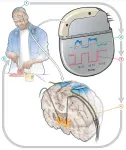(Press-News.org) People with Down syndrome are likely to develop Alzheimer’s disease at a young age, with autopsy studies showing that by age 40 years, the brains of individuals with Down syndrome have amyloid plaques. Yet people with Down syndrome have been excluded from or underrepresented in clinical trials of new therapies for treating AD. Lecanemab, which has been shown to target and remove beta-amyloid plaques, has been approved by the U.S. Food and Drug Administration to treat AD early in the disease’s progression. A new study led by investigators at Brigham and Women’s Hospital (a founding member of the Mass General Brigham healthcare system) and University of California, Irvine tested lecanemab to see if it could bind to amyloid plaques in tissue samples from people with Down syndrome, finding that it effectively targeted amyloid in all 15 samples. However, the drug also bound to brain blood vessels, which raises safety concerns. Results are published in JAMA Neurology.
“Our study is highly clinically relevant, as we focus on the usage of a recently approved disease modifying therapy for Alzheimer’s disease, lecanemab, in people with Down syndrome,” said co-corresponding author Lei Liu, MD, PhD, of the Department of Neurology at Brigham and Women’s Hospital.
“Our findings underscore the exciting promise of anti-amyloid drugs for helping people with Down syndrome, but also the need for careful consideration of safety, especially the risk of hemorrhagic complications,” said co-corresponding author Elizabeth Head, PhD, of the Department of Pathology and Laboratory Medicine at University California, Irvine.
The research team evaluated brain tissue samples from 15 people with Down syndrome who were between the ages of 43 and 68 years. The study was limited in its sample size and age range—in the future, the researchers hope to expand the study to include samples from younger brain donors to determine if age may be a factor in the drug binding to blood vessels. The team also plans to evaluate the drug’s binding profile in people with late-onset AD to see if it follows a similar pattern. The research team expresses its gratitude to the people with Down syndrome for their gift of brain donation.
Disclosures: Dr. Head has served as a scientific advisor for Cyclotherapeutics and Alzheon and is funded by the National Institutes of Health. Dr. Liu is funded by the National Institutes of Health.
Funding: This work was funded by National Institutes of Health grants P30AG066519, U19AG068054, RF1AG079519, R01 AG071865, RF1 AG079569, K08 AG065502, DP2 AG086138, and R01 082346, and Doris Duke Foundation 2021183.
Paper cited: Liu L et al. “Lecanemab and Vascular-Amyloid Deposition in Brains of People with Down Syndrome” JAMA Neurology DOI: 10.1001/jamaneurol.2024.2579
END
Research study examines Alzheimer’s disease drug on tissue samples from people with Down syndrome
The anti-amyloid drug lecanemab bound to amyloid plaques but also bound to blood vessels, suggesting that safety and efficacy need to be closely evaluated
2024-08-19
ELSE PRESS RELEASES FROM THIS DATE:
International Society of Biomechanics recommendations for wearables-based motion capture
2024-08-19
Dr. Reed Gurchiek, an Assistant Professor in the Department of Bioengineering, Clemson University, and an Early-stage Investigator, was a co-first author of a recent publication in the Journal of Biomechanics titled “International Society of Biomechanics recommendations on the definition, estimation, and reporting of joint kinematics in human motion analysis applications using wearable inertial measurement technology”. A collaborative effort that incorporated feedback from the biomechanics community has produced recommendations in five categories: sensor characteristics ...
Rutgers researchers discover new way to control the sense of touch
2024-08-19
Rutgers researchers have found a new way to manage the receptors that control the sense of touch, which could lead to treating chronic pain more effectively.
“Identifying a natural molecule that specifically reduces pain sensitivity offers hope for new therapeutic strategies in the management of pain,” said Tibor Rohacs, a professor in the Department of Pharmacology, Physiology and Neuroscience at Rutgers New Jersey Medical School and a member of the Rutgers Brain Health Institute. “Our goal is to translate these findings into effective treatments that improve the quality of life for people suffering from chronic ...
New UH study targets early signs of vision loss in diabetic patients
2024-08-19
A $3.3 million study at the University of Houston College of Optometry will track the health of patients with prediabetes and diabetes to find out who might develop eye problems and be at risk for future vision loss. The study is being led by Wendy Harrison, associate professor, and is underwritten by the National Eye Institute.
Vision loss in type 2 diabetes results from diabetic retinopathy, caused by damage to blood vessels in the retina, the light-sensitive layer of tissue in the back of your eye. The disease can appear without warning.
“The ...
Herbal-based nutraceuticals in management of lifestyle diseases: Experience from Indian population
2024-08-19
Lifestyle diseases, also known as non-communicable diseases (NCDs), have emerged as a major health burden globally, including in India. These diseases, such as obesity, diabetes, hypertension, cardiovascular diseases, and metabolic disorders, are primarily caused by unhealthy lifestyle choices like sedentary behavior, poor dietary habits, and stress. According to the World Health Organization (WHO), NCDs are responsible for 41 million deaths annually, accounting for 74% of all global deaths. Notably, 86% of these premature deaths occur in low- and middle-income countries.
The increasing prevalence of lifestyle diseases ...
Taming Parkinson’s disease with intelligent brain pacemakers
2024-08-19
Media Contact: Robin.Marks@ucsf.edu, (415) 502-6397
Subscribe to UCSF News
Taming Parkinson’s Disease with Intelligent Brain Pacemakers
UCSF studies show personalized, self-adjusting, neuromodulation has the potential to enhance movement and sleep.
Two new studies from UC San Francisco are pointing the way toward round-the-clock personalized care for people with Parkinson’s disease through an implanted device that can treat movement problems during the day and insomnia at night.
The approach, called adaptive deep brain stimulation, or aDBS, uses methods derived from AI to ...
Self-adjusting brain pacemaker may help reduce Parkinson’s disease symptoms
2024-08-19
A small feasibility study funded by the National Institutes of Health (NIH) found that an implanted device regulated by the body’s brain activity could provide continual and improved treatment for the symptoms of Parkinson’s disease (PD) in certain people with the disorder. This type of treatment, called adaptive deep brain stimulation (aDBS), is an improvement on a technique that has been used for PD and other brain disorders for many years. The study found aDBS was markedly more effective at controlling PD symptoms compared to conventional DBS treatments.
“This study marks a big step forward towards ...
Florida’s red flag gun law and firearm and nonfirearm homicide and suicide rates
2024-08-19
About The Study: Although firearm homicide mortality increased after Florida’s red flag law enactment (permitting the temporary removal of firearms by law enforcement officers from individuals posing a danger to themselves or others), this increase was lower than expected compared with its synthetic control, resulting in an 11% rate reduction (0.73 fewer deaths per 100,000). There were no differences from expected mortality rates for nonfirearm homicide, firearm suicide, or nonfirearm suicide.
Corresponding Author: To contact the corresponding author, Catherine Gimbrone, MPH, email c.gimbrone@columbia.edu.
To ...
Number of pediatric inpatient psychiatric beds in the U.S. did not increase 2017-2020 despite youth mental health crisis
2024-08-19
U.S. pediatric inpatient psychiatric bed capacity did not change 2017 – 2020, despite increases in pediatric mental health emergency visits, according to a study published in JAMA Pediatrics. Researchers also found substantial geographic variation in inpatient psychiatric bed capacity per 100,000 children, ranging from zero in Alaska to 75 in Arkansas. Over 90 percent of pediatric inpatient beds are in urban centers, raising concerns for youth living in rural areas.
“Access to psychiatric inpatient care for youth is insufficient to meet the growing demand, forcing patients to wait for hours or even days in emergency departments or on medical units until a psychiatric bed becomes ...
Using temporary nurses doesn’t mitigate deaths linked with staff shortages
2024-08-19
A new study led by the University of Southampton has found that using temporary nursing staff to fill rotas only partially combats an increased risk of patient death associated with staff shortages.
Researchers found that avoiding low nurse staffing levels lowers the risk of death among patients – particularly even when drafting in temporary registered nurses to maintain staffing levels. However, despite this, the risk of death remains elevated compared to when the ward is fully staffed by permanent nurses.
Findings from the ...
Telehealth mindfulness-based interventions for chronic pain
2024-08-19
About The Study: Scalable telehealth mindfulness-based interventions improved pain-related function and biopsychosocial outcomes compared to usual care among veterans with chronic pain in this randomized clinical trial. Relatively low-resource telehealth-based mindfulness-based interventions could help accelerate and improve the implementation of nonpharmacological pain treatment in health care systems.
Corresponding Author: To contact the corresponding author, Diana J. Burgess, PhD, email diana.burgess@va.gov.
To access the embargoed study: Visit our For The Media website ...
LAST 30 PRESS RELEASES:
Making lighter work of calculating fluid and heat flow
Normalizing blood sugar can halve heart attack risk
Lowering blood sugar cuts heart attack risk in people with prediabetes
Study links genetic variants to risk of blinding eye disease in premature infants
Non-opioid ‘pain sponge’ therapy halts cartilage degeneration and relieves chronic pain
AI can pick up cultural values by mimicking how kids learn
China’s ecological redlines offer fast track to 30 x 30 global conservation goal
Invisible indoor threats: emerging household contaminants and their growing risks to human health
Adding antibody treatment to chemo boosts outcomes for children with rare cancer
Germline pathogenic variants among women without a history of breast cancer
Tanning beds triple melanoma risk, potentially causing broad DNA damage
Unique bond identified as key to viral infection speed
Indoor tanning makes youthful skin much older on a genetic level
Mouse model sheds new light on the causes and potential solutions to human GI problems linked to muscular dystrophy
The Journal of Nuclear Medicine ahead-of-print tip sheet: December 12, 2025
Smarter tools for peering into the microscopic world
Applications open for funding to conduct research in the Kinsey Institute archives
Global measure underestimates the severity of food insecurity
Child survivors of critical illness are missing out on timely follow up care
Risk-based vs annual breast cancer screening / the WISDOM randomized clinical trial
University of Toronto launches Electric Vehicle Innovation Ontario to accelerate advanced EV technologies and build Canada’s innovation advantage
Early relapse predicts poor outcomes in aggressive blood cancer
American College of Lifestyle Medicine applauds two CMS models aligned with lifestyle medicine practice and reimbursement
Clinical trial finds cannabis use not a barrier to quitting nicotine vaping
Supplemental nutrition assistance program policies and food insecurity
Switching immune cells to “night mode” could limit damage after a heart attack, study suggests
URI-based Global RIghts Project report spotlights continued troubling trends in worldwide inhumane treatment
Neutrophils are less aggressive at night, explaining why nighttime heart attacks cause less damage than daytime events
Menopausal hormone therapy may not pose breast cancer risk for women with BRCA mutations
Mobile health tool may improve quality of life for adolescent and young adult breast cancer survivors
[Press-News.org] Research study examines Alzheimer’s disease drug on tissue samples from people with Down syndromeThe anti-amyloid drug lecanemab bound to amyloid plaques but also bound to blood vessels, suggesting that safety and efficacy need to be closely evaluated


